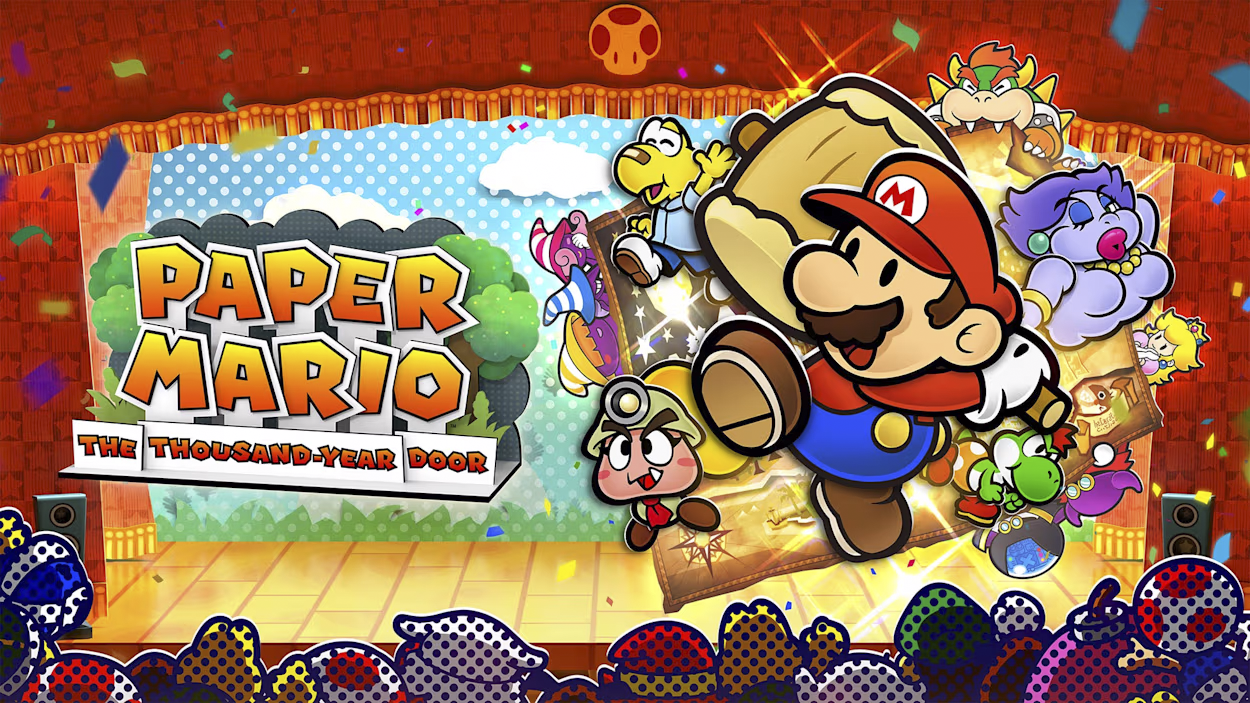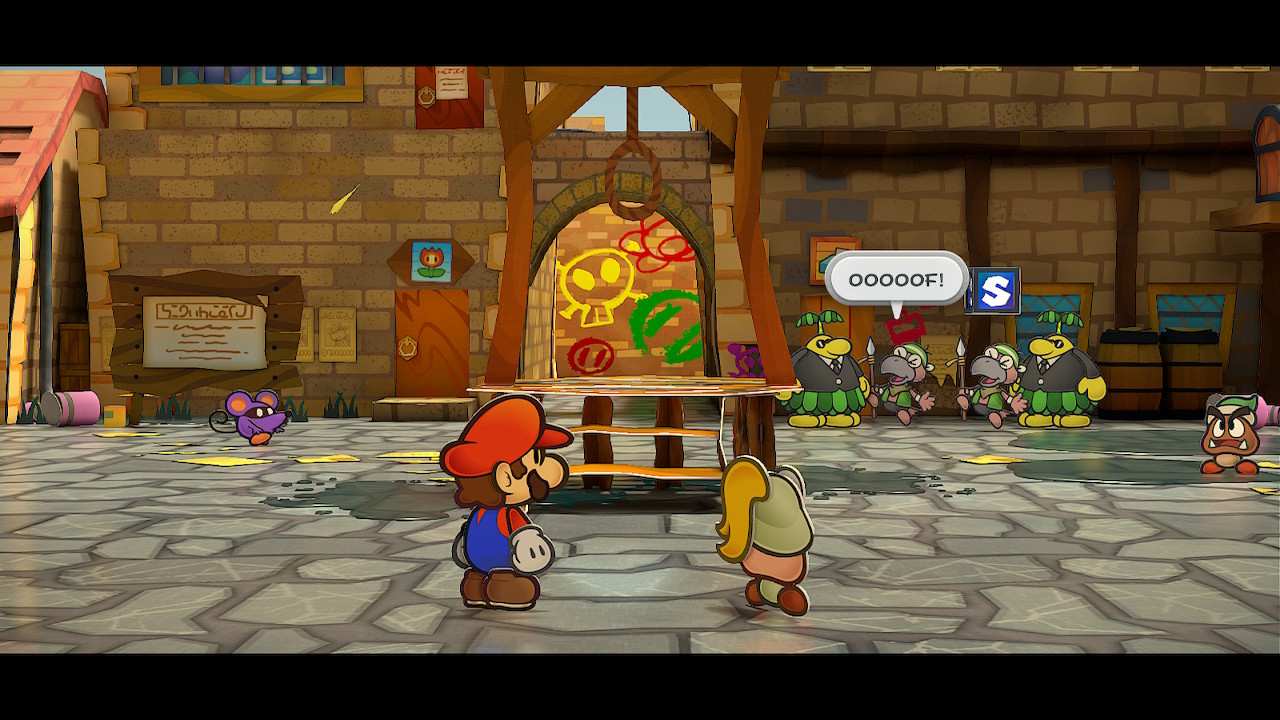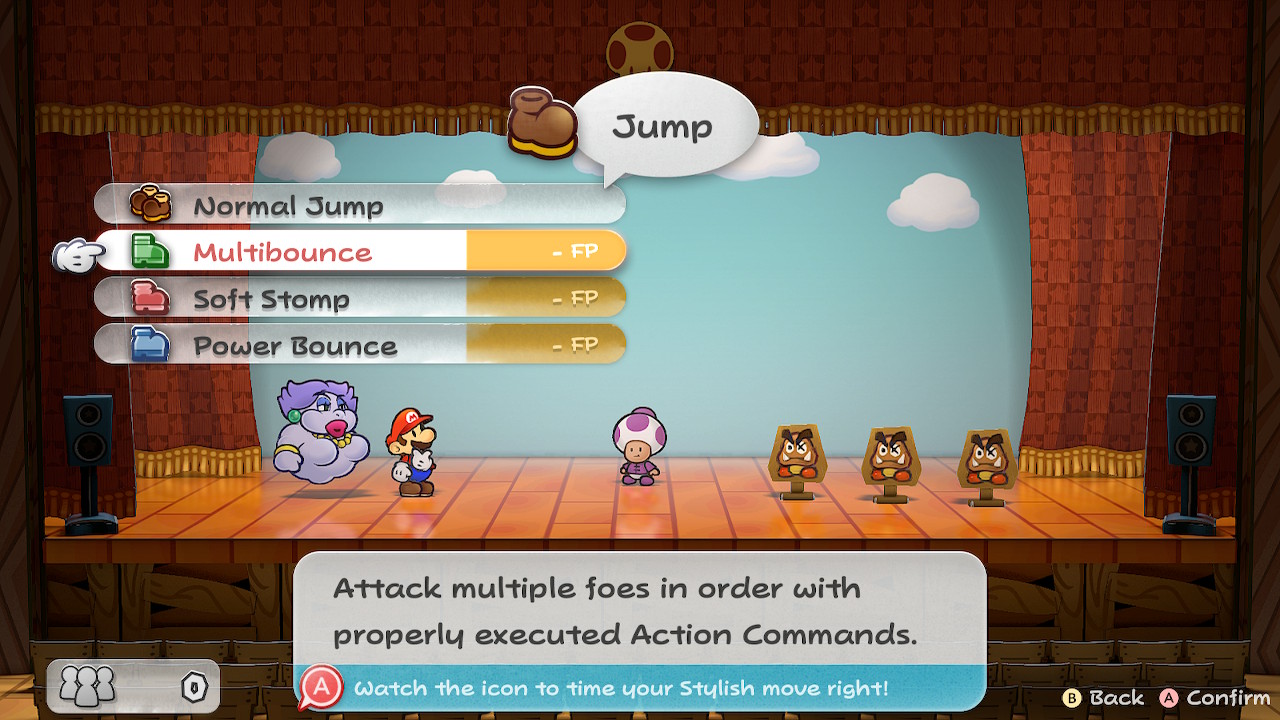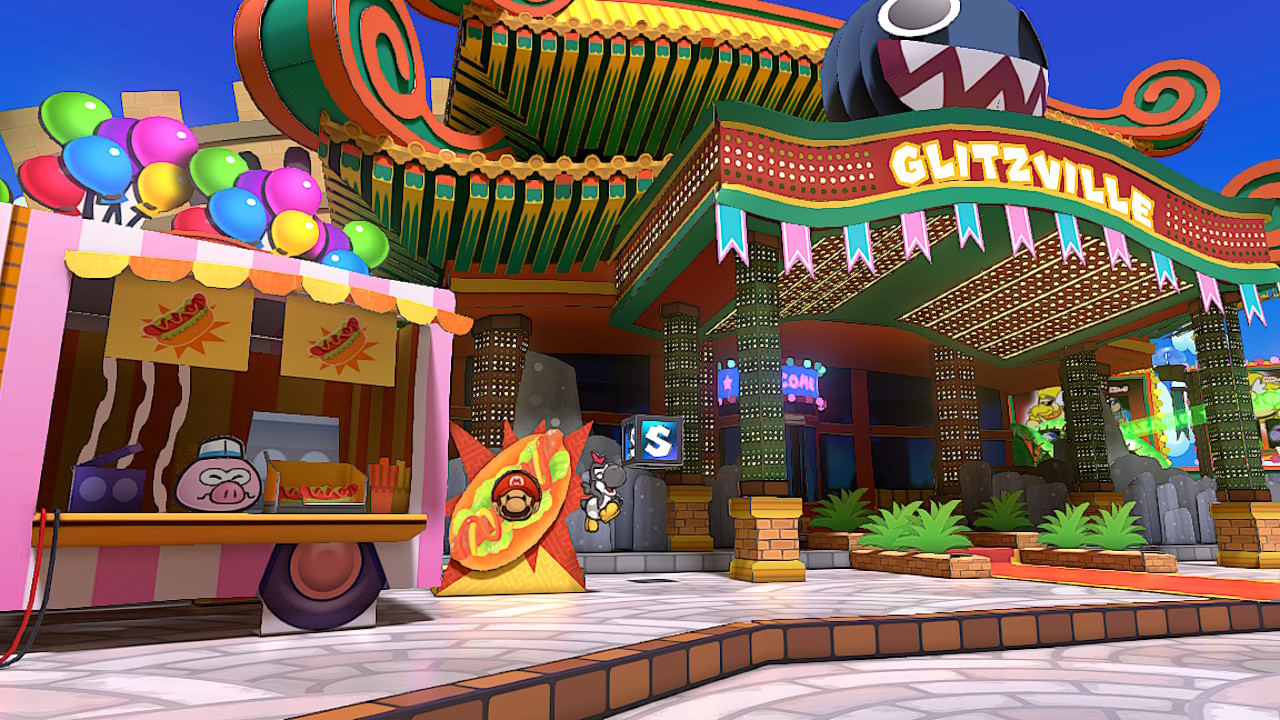Disclaimer: Writer is an investor in Nintendo.

Paper Mario: The Thousand-Year Door was the first RPG I ever reviewed for the site, and I remember the game fondly. I was of course quite excited when it was announced that a remake of this classic GameCube title was coming to Nintendo Switch, but wasn’t sure if it was worth reviewing again. Well, as it turns out, there are a decent number of changes here, and some will drastically affect the morality/parental warnings. Strap in as we once again take a look at the highest-rated Mario RPG!
Plot
The adventure begins at Mario’s home when he receives a letter from Princess Peach. She asks him to come to Rogueport to help her search for an ancient treasure said to lie beneath the city and locked behind the Thousand-Year Door. Upon arrival, Peach is nowhere to be seen – but with the help of the characters Goombella and Professor Frankly, Mario sets out to retrieve seven crystal stars needed to open the door and uncover the ancient mystery.

While the plot may sound simple, it’s the environment and characters that make it interesting. If you can’t tell by the noose hanging in the center of town, Rogueport is a seedy place. Many criminals make their home along rival gangs caught in a turf war. In fact, Mario gets mugged almost immediately after arriving! Such a setting lies in stark contrast to pretty much any other place in the entire Mario series, and it’s a joy seeing classic characters modified to fit the scene. This remains a constant throughout the game and is one of the reasons it’s so beloved. How can you say no to the Pianta Mafia?
At times the mood gets heavier, too – I won’t dive into details, but you can expect to hear about the struggles certain characters face, such as lack of fulfillment or even the death of loved ones. While many jokes are still present, don’t expect humor to play the leading role. The original script has undergone many adjustments, but I’ll get to that later as it covers the most controversial aspect of this remake.
Gameplay
Unlike the more recent Paper Mario games, this one is an RPG through-and-through. You fight enemies in turn-based battles, in which Mario and the various partners he meets can power up their moves via action commands. For example, you may need to press A right as you jump on an enemy or hold the control stick back as Mario charges a hammer swing. While some moves are easy to pull off consistently, others such as your special moves can be difficult to master.

There is also a badge system that accompanies this gameplay and allows you immense freedom to customize your experience. You can play it risky by equipping badges that improve Mario’s attack and defense when his HP is low, or take it slow with badges that slowly restore HP and FP over time. Or you could add a variety of new moves to his arsenal! There are even some badges that increase the damage Mario takes if you want to raise the difficulty of this otherwise easy adventure.
You don’t spend all your time in battle, of course – most of the time you’ll be exploring on foot, using partners’ abilities to solve puzzles and Mario’s paper transformations to navigate. You might turn into a paper airplane to cross huge gaps or turn sideways to slip through small cracks. While these are enjoyable, few of the puzzles offer a real challenge and much of the time you can decipher the solution after mere seconds. Additionally, the game often asks you to backtrack for pretty arbitrary reasons (usually to go get some random item) which can kind of kill the pacing.
Thankfully, Nintendo took the time to add in some quality of life features for this remake. You can now access the partner wheel by pressing L, and fast-travel points are added to each area upon the completion of its chapter, just to name a few. Unfortunately, there are also a few downsides compared to the original. The menus are a little slower to navigate, and the game now runs in 30 fps instead of 60 like on the GameCube. These are pretty small nitpicks for an RPG, but worth mentioning nonetheless.

Graphics
I was surprised to see that the developers appear to have remade every single asset – and I’m glad they did. The original game didn’t do an amazing job representing the pop-up book aesthetic we see more clearly in other Paper Mario titles. This remake set out to fix that, and struck an amazing balance keeping the original feel intact while also making sure everything is actually made of paper. While I rarely noticed stuttering, the game did slow down a couple times.

Music
Paper Mario: The Thousand-Year Door had an already amazing soundtrack that has now been remastered with new additions. Some of my favorites are the Rogueport overworld & sewers themes, as well as Professor Frankly’s theme. As for changes, the classic battle theme now adapts based on which area you’re in. Oh, and if you’d like things to go back to the way they were, you can equip the “Nostalgic Tunes” badge to restore the original GameCube music!
Changes to the original script
Alright, this is the section I wasn’t looking forward to, but I’ve got to talk about it. As expected, the script isn’t perfectly carried over from the original. Most of the changes are pretty small, but all eyes were on Nintendo to see how’d they handle the character Vivian.
Vivian is traditionally known as one of the three shadow sisters, struggling with an inferiority complex as the oldest sister constantly throws insults. However, they have some controversial history behind them. In most of the original GameCube versions of the game, Vivian was portrayed as either a cross-dresser or a male identifying as a transgender woman. Beldam would sometimes have issues with this – for example, after Vivian refers to the three as sisters in the original French version, Beldam responds “Quoi! Viviane! Qu’est-ce que tu racontes? L’Obscur Trio! Tout court! Où tu vois trois sœurs, toi? Tu es un garçon!!!!!!” (“What! Vivian! What are you talking about? The Dark Trio! Period! Where do you see three sisters? You’re a boy!”)
This aspect of the character was removed entirely from the original English localization, with Vivian simply presented as another sister and Beldam slinging gender-neutral insults. However, with this remake, Vivian is now consistently presented in all versions of the game to identify as a transgender woman (see screenshot below). Vivian at one point tells Beldam “…it makes me really happy when you call me your sister”, and all characters reference Vivian as female from the start.

I was surprised to see this from Nintendo, who has traditionally tried pretty hard to stay out of the culture war. From what I could tell, it is really just this single line in the screenshot above where Vivian’s transgender status is ever mentioned, so it isn’t elaborated on. Nevertheless, I am sad to see this dangerous ideology (taking feelings as truth) being the implied solution to those that live with the immense struggle that is gender dysphoria. Peace is not found in trying to conform reality to our desires, but rather in conforming ourselves to reality. I’d also like to stress that the issue is within the game’s treatment – not its inclusion – of a character with gender dysphoria.
I’ll end this with an excerpt from Amoris laetitia:
“Beyond the understandable difficulties which individuals may experience, the young need to be helped to accept their own body as it was created, for ‘thinking that we enjoy absolute power over our own bodies turns, often subtly, into thinking that we enjoy absolute power over creation… An appreciation of our body as male or female is also necessary for our own self awareness in an encounter with others different from ourselves. In this way we can joyfully accept the specific gifts of another man or woman, the work of God the Creator, and find mutual enrichment.”
– Pope Francis
Conclusion
Paper Mario: The Thousand-Year Door is in my opinion the greatest in the series, and if you suspend the controversial script change, I’d say this is the best remake we could have hoped for. It was definitely the right game to remake and worth the attention. I doubt the treatment of Vivian’s character will be a spiritual roadblock for most, but parents especially should consider this aspect when deciding if the game is right for their kids.
Scoring: 95%
Story: 4.5/5
Gameplay: 4.5/5
Graphics: 5/5
Music: 5/5
Morality/Parental Warnings
Sex/Nudity: Mario gets kissed by several characters, some of whom also flirt with him. Some vague sexual jokes are made, e.g. “shaking what my momma gave me!” At one point a female character undresses, but only after drinking an invisibility potion.
Violence: Slapstick cartoon violence is present and characters fight with hammers or swords. No blood or visible injuries are present.
Magic/Occult: There are several characters themed around fortune tellers, telling Mario the future, placing beneficial spells on him, and the like. One of the bosses you fight is referred to as a demon. Some characters get possessed at certain points in the story.
Miscellaneous: One of Mario’s partners, Vivian, identifies as a transgender woman, also having a crush on Mario and kissing him.
